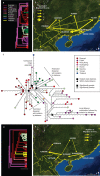Influenza A H5N1 immigration is filtered out at some international borders
- PMID: 18301773
- PMCID: PMC2244808
- DOI: 10.1371/journal.pone.0001697
Influenza A H5N1 immigration is filtered out at some international borders
Abstract
Background: Geographic spread of highly pathogenic influenza A H5N1, the bird flu strain, appears a necessary condition for accelerating the evolution of a related human-to-human infection. As H5N1 spreads the virus diversifies in response to the variety of socioecological environments encountered, increasing the chance a human infection emerges. Genetic phylogenies have for the most part provided only qualitative evidence that localities differ in H5N1 diversity. For the first time H5N1 variation is quantified across geographic space.
Methodology and principal findings: We constructed a statistical phylogeography of 481 H5N1 hemagglutinin genetic sequences from samples collected across 28 Eurasian and African localities through 2006. The MigraPhyla protocol showed southern China was a source of multiple H5N1 strains. Nested clade analysis indicated H5N1 was widely dispersed across southern China by both limited dispersal and long distance colonization. The UniFrac metric, a measure of shared phylogenetic history, grouped H5N1 from Indonesia, Japan, Thailand and Vietnam with those from southeastern Chinese provinces engaged in intensive international trade. Finally, H5N1's accumulative phylogenetic diversity was greatest in southern China and declined beyond. The gradient was interrupted by areas of greater and lesser phylogenetic dispersion, indicating H5N1 migration was restricted at some geopolitical borders. Thailand and Vietnam, just south of China, showed significant phylogenetic clustering, suggesting newly invasive H5N1 strains have been repeatedly filtered out at their northern borders even as both countries suffered recurring outbreaks of endemic strains. In contrast, Japan, while successful in controlling outbreaks, has been subjected to multiple introductions of the virus.
Conclusions: The analysis demonstrates phylogenies can provide local health officials with more than hypotheses about relatedness. Pathogen dispersal, the functional relationships among disease ecologies across localities, and the efficacy of control efforts can also be inferred, all from viral genetic sequences alone.
Conflict of interest statement
Figures





References
-
- Yuen KY, Wong SS. Human infection by avian influenza A H5N1. Hong Kong Med J. 2005;11:189–199 (2005). - PubMed
-
- Kandun IN, Wibisono H, Sedyaningsih ER, Yusharmen, Hadisoedarsuno W, et al. Three Indonesian clusters of H5N1 virus infection in 2005. N Engl J Med. 2006;355:2186–2194. - PubMed
-
- Rweyemamu M, Paskin R, Benkirane A, Martin V, Roeder P, et al. Emerging diseases of Africa and the Middle East. Annals of New York Academy of Sciences. 2000;916:61–70. - PubMed
Publication types
MeSH terms
Substances
Grants and funding
LinkOut - more resources
Full Text Sources
Medical
Research Materials

